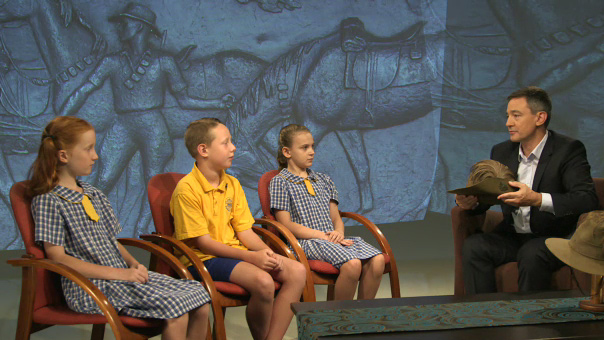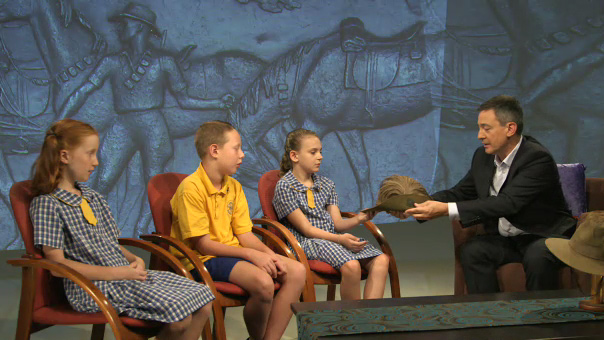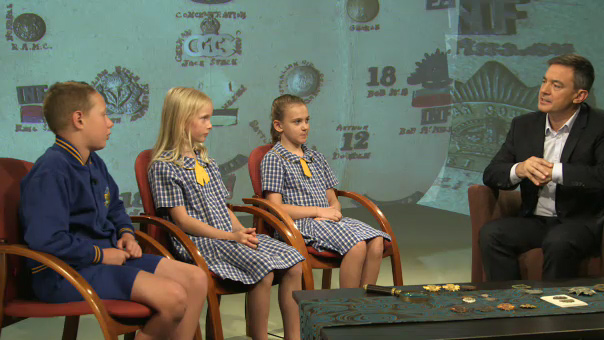Viewing guide
The Australian Light Horsemen were mounted soldiers who wore a distinctive addition to their uniform. Take a look at Trooper A.C. Wooster of the 2nd Light Horse in his uniform.
What are the special features of Trooper Wooster’s uniform?
Why do you think he wore emu feathers in his hat?
Find answers to these questions and more in the videos.
Think about:
-
why the horses were so important to the soldiers
-
difficulties the soldiers and horses might have experienced while on board the ship
-
the difficulties for the horses in the hot desert climate
-
symbols that represent the Australian Light Horsemen
-
why it is important to remember our Anzac soldiers.
Anzac stories is a suite of videos relating to aspects of the First World War. Slouch hat feathers—part 1 is a Stage 2 history resource that focuses on Anzac symbols and commemoration.
In this video the senior historian from the ANZAC Memorial displays a historical artefact, a slouch hat with emu plumes, to a group of students and discusses its symbolism and the role of the Light Horse. Anzac stories—part 2 follows on from this video providing more information about the Light Horse and their emu plume symbol.
This video resource addresses the following NSW Board of Studies, Teaching & Educational Standards, history Stage 2 syllabus outcomes.
A student:
-
identifies celebrations and commemorations of significance in Australia and the world (HT2-1)
-
applies skills of historical inquiry and communication
Days and weeks celebrated or commemorated in Australia (including Australia Day, ANZAC Day, Harmony Week, National Reconciliation Week, NAIDOC Week, National Sorry Day) and the importance of symbols and emblems (ACHHK063)
Students:
-
identify and describe local, state and national symbols and discuss the origins, symbolism and significance, eg the school logo, Australian and Aboriginal and Torres Strait Islander flags, coats of arms from states and Australia
-
identify important Australian celebrations and commemorations and discuss their origins and significance in society.
Brad Manera: This is an Australian slouch hat with emu plumes. It's the symbol of the soldiers who rode to war from Australia—the Australian Light Horse. The slouch hat has been associated with the Australian Army for well over 100 years. But the men who rode horses to war, our Australian Light Horse, looked just a little bit different. They wore a slouch hat with emu plumes. It made them very distinctive. It's become one of our great symbols from Australia's military past.
Cooper: Why did they need horses in the war?
Brad Manera: The First World War was fought 100 years ago and it's very important on a battlefield to be able to move your soldiers around the battlefield more quickly than the enemy can. And so, a man on a horse can move much more quickly and over much longer distances than a man on foot. That's the difference between a light horseman and an infantryman. An infantryman marches to war. A light horseman rides a horse. And so, he can ride forward of the rest of the army, find out where the enemy are, ride back and tell the headquarters, his commanders, where the enemy are and what they're doing, so that they can allocate their soldiers appropriately to try and win that battle.
Isabella: How did they get their horses to the war front?
Brad Manera: Most of the horses that the Australian Light Horse rode came from Australia, so they were part of a journey that our soldiers had taken. Australia had been sending horses to the British Army for decades before the First World War. And most of them were sold through businesses in NSW, and so the horses became known as Walers. The Australian Light Horse rode Walers in the Middle East. And they had to round them up from properties around Australia, get them onto troop ships and ship them all the way to the Middle East where they were being ridden by our light horsemen in battle. So if it was a long and boring, sometimes frightening journey for our soldiers, imagine how much worse it was for the horses. They couldn't understand being cooped up on transport ships for weeks, sometimes months. It was hot, it was cramped, the water was stale, the food was stale. It was a very difficult journey for those horses going to war.
Stella: How did they look after the horses while they were at war?
Brad Manera: It was essential to care for the health of the horse. Every soldier had to look after his horse. They... Every soldier groomed his horse every day. And every regiment had veterinary soldiers serving with them, to make sure that they could cure minor ailments for the horses while they were on the march. Every soldier had spare horseshoes in a wallet attached to his saddle. So, while they were on campaign in the desert, every soldier was being aware of how fit his horse was, whether his horse was coping with the heat. They could carry enough food for the horses for two or three days. But they could never carry enough water. So it was essential that they captured water wells because horses get very, very stressed if they don't get water every day. Sometimes they can go two days, but if it's much longer than that, the horse really starts to suffer.
Cooper: What did the light horsemen need to carry on their horses?
Brad Manera: The light horsemen needed to carry just about everything on his horse. He carried his weapon and his ammunition strapped to his chest and his back, but the horse carried everything else. It could be over 160 kilos of weight—saddle, man, sleeping equipment, food, rations and weapon. Some of the photographs we see from the Middle East, it looks like there's a dismantled tent with four legs underneath it. They carried extraordinary loads long distances in harsh climates.
Before student viewing
Discuss with students the meaning of the word ‘symbol’.
Ensure that students identify the slouch hat and the emu plumes as features of Trooper A.C. Wooster’s uniform.
You might like to begin reading with students, Midnight by author Mark Greenwod.
During student viewing
During viewing students should consider the viewing guide questions. You might need to play the video a second time. Use the questions for discussion at the completion of the video viewing.
After student viewing
Set up an online collaborative tool such as a Google Doc, Office 365 Word doc or a lino canvas where students can add their ideas about symbols, emblems, sounds and objects associated with Anzac.
Before students begin their research discuss key questions to guide the research. These might include:
-
What is the symbol, emblem, sound or object you will research?
-
How did it originate?
-
What is its meaning?
-
Why is it important today?
Students’ multimedia digital presentations could include:
-
photos or personal artworks with audio or written comments
-
a podcast
-
a video cast.
These presentations could be used in an Anzac or Remembrance Day ceremony or presented to another class.
Resources to support learning activities in Slouch hat feathers—part 1.
Although this website is copyright NSW Department of Education, we would like to acknowledge the sources for images.



